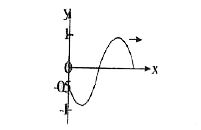A wave travelling along positive x-axis is given by y=Asin(ωt−kx). If it is reflected from rigid boundary such that 80% amplitude is reflected, then equation of reflected wave is
y=Asin(ωt+kx)
y=−0.8Asin(ωt+kx)
y=Asin0.8A(ωt+0.8kx)
y=Asin(ωt+0.8kx)
The correct Answer is:A
To find the equation of the reflected wave when a wave traveling along the positive x-axis is reflected from a rigid boundary with 80% of its amplitude reflected, we can follow these steps:
1. Identify the Incident Wave Equation:
The incident wave is given by the equation:
y=Asin(ωt−kx)
where A is the amplitude, ω is the angular frequency, and k is the wave number.
Hint: Recognize that the wave travels in the positive x-direction due to the negative sign in the argument of the sine function.
2. Determine the Amplitude of the Reflected Wave:
Since 80% of the amplitude is reflected, the amplitude of the reflected wave, denoted as A′, can be calculated as:
A′=0.8A
Hint: Remember that the amplitude of the reflected wave is a fraction of the incident wave's amplitude.
3. Consider the Phase Change upon Reflection:
When a wave reflects off a rigid boundary, it undergoes a phase change of π radians (or 180 degrees). This means that the reflected wave will have a phase shift added to its equation.
Hint: A phase change of π indicates that the wave will be inverted.
4. Write the Equation for the Reflected Wave:
The general form of the reflected wave traveling in the negative x-direction can be expressed as:
yr=A′sin(ωt+kx+π)
Substituting A′=0.8A:
yr=0.8Asin(ωt+kx+π)
Hint: The sine function has a property: sin(x+π)=−sin(x).
5. Simplify the Equation:
Using the property of sine:
yr=0.8Asin(ωt+kx+π)=−0.8Asin(ωt+kx)
Hint: The negative sign indicates that the reflected wave is inverted compared to the incident wave.
Final Answer:
The equation of the reflected wave is:
yr=−0.8Asin(ωt+kx)
The incident wave is given by the equation:
y=Asin(ωt−kx)
where A is the amplitude, ω is the angular frequency, and k is the wave number.
Since 80% of the amplitude is reflected, the amplitude of the reflected wave, denoted as A′, can be calculated as:
A′=0.8A
When a wave reflects off a rigid boundary, it undergoes a phase change of π radians (or 180 degrees). This means that the reflected wave will have a phase shift added to its equation.
The general form of the reflected wave traveling in the negative x-direction can be expressed as:
yr=A′sin(ωt+kx+π)
Substituting A′=0.8A:
yr=0.8Asin(ωt+kx+π)
Using the property of sine:
yr=0.8Asin(ωt+kx+π)=−0.8Asin(ωt+kx)
The equation of the reflected wave is:
yr=−0.8Asin(ωt+kx)
Topper's Solved these Questions
- WAVESBook:AAKASH SERIESChapter:WAVESExercise:EXERCISE-II (Strings (Speed of a travelling wave:))
Explore 23 Videos
- WAVESBook:AAKASH SERIESChapter:WAVESExercise:EXERCISE-II (Velocity of Sound:)
Explore 8 Videos
- WAVESBook:AAKASH SERIESChapter:WAVESExercise:EXERCISE-IB (Assertion (A) & Reason (R) Type Questions)
Explore 72 Videos
- WAVE OPTICSBook:AAKASH SERIESChapter:WAVE OPTICSExercise:PROBLEMS (LEVEL - II)
Explore 33 Videos
- WAVES OPTICSBook:AAKASH SERIESChapter:WAVES OPTICSExercise:EXERCISE -III (POLARISITION)
Explore 10 Videos
Similar Questions
The equation of a plane wave travelling along positive direction of x−axis is y=asin2πλ(vt−x) When the wave is reflected at a rigid surface and its amplitude becomes 80%, then find the equation of the reflected wave.
View SolutionA wave is reflected from a rigid support. The change in phase on reflection will be
View Solution
Knowledge Check
Equation of a plane progressive wave is given by y=0.6sin2π(t−x2). On reflection from a denser medium, its amplitude becomes 2/3 of the amplitude of the incident wave. The equation of the reflected wave is
Ay=0.6sin2π(t+x2)By=−0.4sin2π(t+x2)Cy=0.4sin2π(t+x2)Dy=−0.4sin2π(t−x2)A wave undergoes reflection from a rigid boundary. One of its characteristic parameters that changes is
AfrequencyBphaseCvelocityDwavelength
Equation of a plane progressive wave is given by y=0.6sin2π(t−x2). On reflection from a denser medium, its amplitude becomes 2/3 of the amplitude of the incident wave. The equation of the reflected wave is
View SolutionA wave travels on a light string. The equation of the waves is y=Asin(kx−ωt+30∘). It is reflected from a heavy string tied to an end of the light string at x = 0. If 64% of the incident energy is reflected, then the equation of the reflected wave is
View SolutionThe change in phase if a wave is reflected from a rigid surface is
View SolutionA transverse wave travelling along the positive x-axis, given by y=Asin(kx−ωt) is superposed with another wave travelling along the negative x-axis given by y=Asin(kx+ωt). The point x=0 is
View SolutionA travelling wave y=Asin(kx−ωt+θ) passes from a heavier string to a lighter string . The juction of the strings is at x=0. The equation of the reflected wave is
View SolutionThe equation of a wave travelling along the positive x-axis, as shown in figure at t = 0 is given by

View Solution

